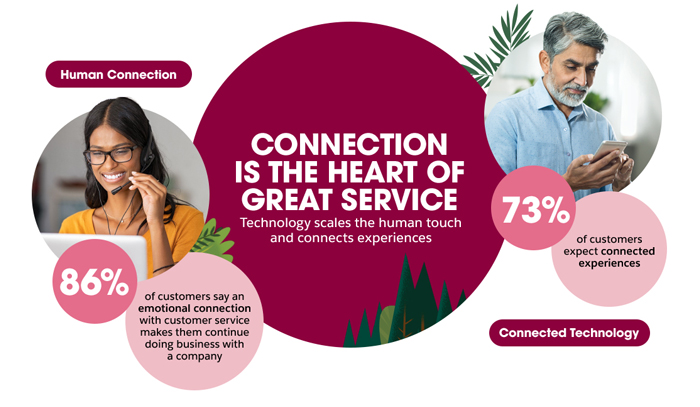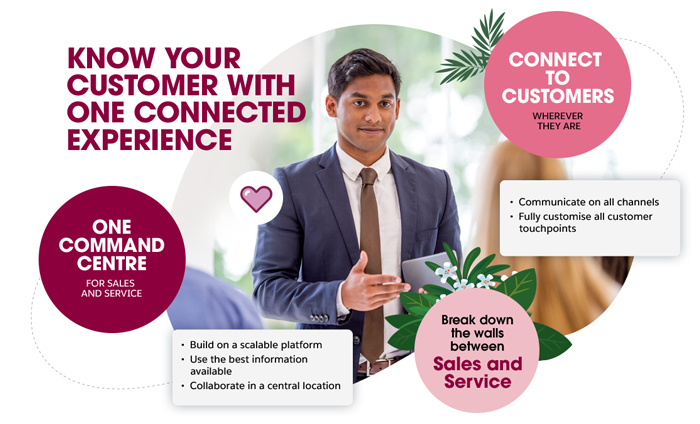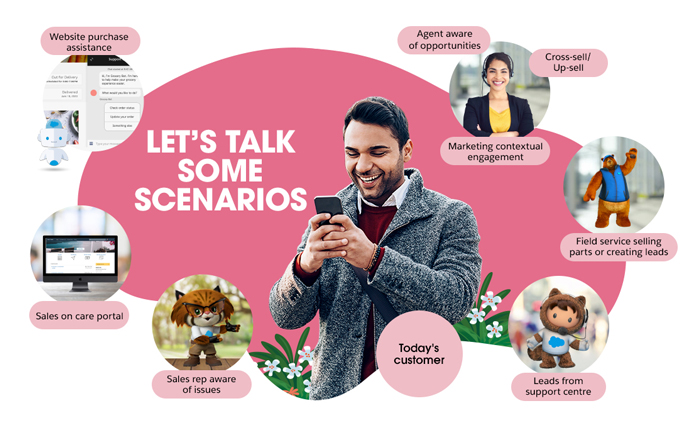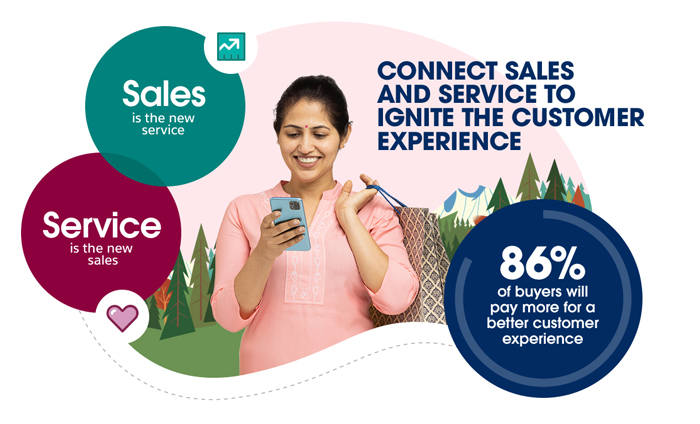Back in the day, customer service was simple. Most queries were resolved over the phone or email. And support was largely reactive – agents didn’t have to do much till a customer reached out.
But today, customers are placing greater stock in proactive, personalised, and omni-channel service. Ninety-one percent of customers say they’re more likely to make another purchase after a great service experience.
In other words, service is no longer just about ‘repair and recovery’ – it’s also an opportunity to drive sales. Agents have the power to influence purchasing decisions. But for this, backend systems between service and sales teams need to be integrated. Here’s why.
Customers are increasingly demanding a connected experience across touchpoints. If they call a service centre to learn more about a sales offer received via SMS, they expect the agent to have all the offer details at hand. Similarly, if they’re trying to get a product issue resolved, they expect that a sales rep won’t try and sell them more products till the problem is sorted out.

Unfortunately, these connected experiences across sales and service are rare. Fifty-four percent of customers say it generally feels like they’re communicating with separate departments, not one company. And 65% say they often have to repeat or re-explain information to different representatives.
The problem usually occurs when:
- Customer data is scattered across emails, text messages, and other silos – so, neither Service nor Sales has a complete customer view
- A service agent or sales rep resigns, leaving behind gaps in customer knowledge
- Service doesn’t share data with Sales and vice versa
The solution? Break down the walls between Service and Sales
When Service and Sales are unified around a single source of customer truth, they can better understand and meet customer demands. A shared customer view enables them to connect the dots across the customer’s journey, and deliver those seamless experiences that customers love.
From a service perspective, a unified CRM empowers agents with all the customer data they need to hyper-personalise support, and provide trusted advice. It also empowers them to transform each service interaction into an opportunity to cross-sell and upsell, thus improving revenue.

How a connected CRM platform can help transform Service into the new Sales

Enable assisted website sales
Imagine a prospect is browsing an insurance website, but doesn’t know which policy is right for them. Confused, they’re about to exit the site when a service chatbot pops up to help. By asking the prospect a few targeted questions about their needs, the bot helps them find a great policy. Straight away, a customer relationship is established.A few months later, the customer calls the service centre with a query about their policy statement. The agent has a 360-degree customer view on their CRM. So, they can see that the customer recently browsed the website for a life insurance policy.
The agent gently inquires if the customer is still interested in the policy. Turns out they are. So, the agent immediately creates a lead in the CRM which is then transferred to a sales rep to complete the transaction. Thus, the agent has changed the game, and transformed a simple service interaction into a sales opportunity.
Transform the care portal into a sales engine
Some companies offer service portals where customers can monitor the status of a ticket, handle returns, download invoices, and more. But what if these service portals could also be used for sales?Let’s say a customer logs onto a furniture company’s care portal to learn how to install a table they purchased the previous week. There they see a pop-up from the underlying CRM which has analysed the customer’s data to recommend an ergonomic chair and floor protecting mat that will go well with the purchased table.
The interested customer clicks on the pop-up window and is redirected to a payments page to complete the transaction. Voila - another seamlessly connected service-to-sales experience
Avoid a leakage of prospects from the call centre
Many times, leads generated in a call centre get lost in a maze of internal emails before they even reach the sales team. But if you have a common platform that connects Sales and Service, then leads can flow seamlessly between the two.Let’s say a prospect calls an automobile call centre to enquire about a new range of sedans. Through the CRM, the prospect’s details are instantly captured by the agent, and transferred to the nearest dealership. The dealer calls the customer back within five minutes, picking up the conversation right from where the service agent left off. With the dealer’s help, the customer identifies a premium sedan and agrees to do a test-drive. They’re thrilled with the quick and connected service they’ve received.
Generate leads from field service
Field service agents aren’t just great product installers or repairers - they’re also brand ambassadors.Imagine that an air conditioner (AC) service technician visits a customer’s house to fix a leaking AC. There they discover that the customer is thinking about fitting a new AC in their guest room. Immediately, the technician creates a lead on their mobile CRM app which is transferred to a sales rep. In a few minutes, the rep calls the customer, and guides them through the process of purchasing a new AC.
Elevate buying experiences by connecting sales and service
Through a connected CRM, service agents can have a complete view of the customer’s purchasing history and potential sales opportunities. For example, an agent may discover that the customer complaint on which they’re working is for a high value customer that’s looking to purchase an enterprise software licence. Knowing this, the agent can decide to prioritise and accelerate case resolution, so that the customer’s purchasing journey isn’t delayed.In some cases, the agent can even sweeten the deal by offering the customer a 10% discount on their next software purchase as a loyalty benefit. The agent isn’t the one making this decision – it’s the CRM software which uses predefined algorithms to calculate a benefit that will delight the customer.
Sales reps too should be aware of the customer’s service history, including open cases and previous complaints. They can then mould their pitch and tone to be more empathetic. For example, a sales rep might see through their CRM that a customer whose software licence is up for renewal, is also in the midst of resolving a service issue. So, when the rep calls the customer, the first thing they do is update them about the issue status. They also offer to extend the customer’s renewal deadline. The customer sees that the company truly cares about service and experience over sales. This makes them more loyal to the brand.
Each of these scenarios demonstrates how a unified sales and service experience can be a powerful differentiator. It helps service teams transform from problem-solvers to sellers, while also enabling sales teams to transform from sellers to advisors.

Bring Sales and Service together with Salesforce Customer 360
Salesforce gives you one platform with one 360-degree view of your customers, so that you can deliver one consistent experience across Sales and Service. Salesforce Customer 360 breaks down the silos between teams, enabling everyone to collaborate more productively, and coordinate customer journeys with ease.
Here’s how that benefits the CRM solution users in particular:
- Know customer betters: All customer data, ranging from previous purchases to service history, is consolidated in a single place. So, teams can deliver truly hyper-personalised and empathetic service, elevating how customers see your brand.
- Optimise revenue: At the click of a button, you can identify what customers desire, need, or hope for – sometimes even before customers know it themselves. This enables them to not only enhance customer trust, but also spot opportunities to upsell and drive revenue.
- Increase productivity: Thanks to streamlined processes, information flows seamlessly between Sales and Service. So, agents can work faster to resolve customer issues, transfer leads to Sales, and engage effectively across channels.





